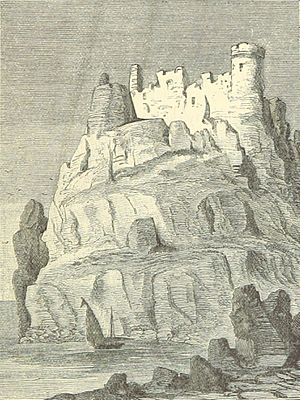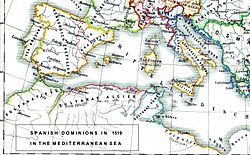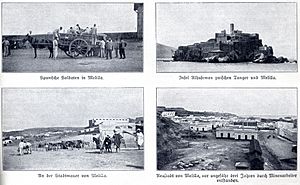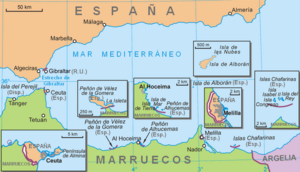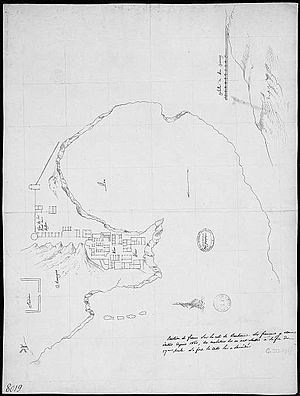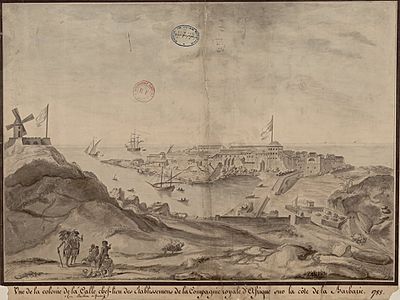European enclaves in North Africa before 1830 facts for kids
The European enclaves in North Africa were like small pieces of European countries located along the coast of North Africa. These were towns, forts, and trading spots that different European powers took over a long time ago. They did this before they had the power to control the whole area.
The first of these places were set up around the 11th century by Italian kingdoms and trading cities. Later, Spain and Portugal became the main European countries involved. France and, for a short time, England also had some of these spots. Most of these enclaves were left by the late 1700s. Today, only the Spanish cities of Ceuta, Melilla, and some smaller islands called Plazas de soberanía are left.
Contents
Italian and Sicilian Settlements

Around the year 1000, small groups of traders from Italian cities like Amalfi and Pisa started appearing in North Africa. These cities made trade deals with the local rulers. As the power of these rulers weakened, the Italian cities became bolder. Pisa tried to take the Balearic Islands in 1114. Genoa attacked Bejaia in 1134 and later teamed up with Pisa to take Annaba in 1136. Pisa also raided Tabarka in 1140.
These Italian efforts were mainly focused on controlling the valuable coral trade. Records show that the coastal area of Marsacares (now El Kala) was sometimes controlled by Pisa and later by Genoa.
The Normans from Italy also got involved. Roger II of Sicily took Djerba in 1135. Then, they captured several Tunisian coastal cities, forming a short-lived area known as the Norman Kingdom of Africa.
However, after leaving Mahdia in 1160, the Normans no longer controlled any places on the North African coast. Later, in 1284, the new ruler of Sicily, Frederick III, invaded Djerba again and held it until 1333. It was taken back for Sicily by Manfredi Chiaramonte, who became the island's lord and also seized the Kerkennah Islands. The Sicilian soldiers left the island in 1392.
After this, the only Italian places in North Africa belonged to Genoa. They held Jijel (in Algeria) and Tabarka (in Tunisia), keeping Tabarka from 1540 to 1742.
Here are some of the places the Italians controlled:
- Jijel (sometimes before 1514)
- Mers el-Kharez (now El Kala) (11th-12th centuries)
- Tabarka (1540-1742)
- Norman Kingdom of Africa (1148–1160)
- Djerba (1135–1158, 1284–1333, 1389–1392)
Portuguese Settlements
The Portuguese presence in North Africa began when King João I led the conquest of Ceuta in 1415. It continued until El Jadida was left in 1769. These enclaves, mostly along the Atlantic coast of Morocco, were known in Portugal as "the Algarve on the other side" ('Algarve de Além').
Taking Ceuta was seen as a holy war by the Pope. But owning the city didn't bring Portugal much money, as trade simply moved to other nearby cities. So, João's successor, King Duarte, tried to take Tangier in 1437 but failed. It wasn't until Duarte's son, Afonso V, that Portugal could expand. He took Ksar es-Seghir in 1458 and Arcila in 1471. He also retook Tangier for a short time. Afonso was called o Africano (the African) because of his conquests.
In 1486, King Joao II captured and fortified El Jadida (Mazagan) as the Portuguese moved south. Two years later, he gained control of Safi.
The remaining Portuguese conquests in Morocco were made by King Manuel I. These included Agadir, Essaouira, and Azemmour. El Jadida was retaken after being lost earlier. In 1508, Portugal took direct control of Safi. Mehdya was taken in 1515 but lost soon after in 1541. The old pirate base at Anfa, which the Portuguese had destroyed in 1468, was reoccupied and fortified in 1515. It became known as "Casa Branca," which eventually led to the name Casablanca.
By the time of King Joao III, the Portuguese empire had spread worldwide. Keeping or expanding the places in Morocco didn't seem worth it financially or militarily. In 1541, Agadir fell to the local ruler Moulay Muhammad. In the same year, Portugal also lost Safi and Azamor. In 1550, they lost Ksar es-Seghir and Arcila.
In 1577, Sebastian I of Portugal managed to retake Arcila, but it was taken by Almanzor in 1589. Sebastian's terrible war in Morocco cost him his life and ended Portugal's expansion. It even led to Portugal losing its independence for a period (1580-1640).
In 1640, Portugal became independent again, but Ceuta chose to stay with Spain. This was officially agreed in 1668. After this, Portugal only had three enclaves in North Africa: Tangier, Casablanca, and El Jadida. Tangier was given to England in 1661 as part of a marriage agreement. Casablanca was abandoned after a big earthquake in Lisbon in 1755. Under attack by Muhammad III, El Jadida was left on March 10, 1769. This ended the Portuguese presence in North Africa.
Here are some of the places the Portuguese controlled:
- Agadir (1505–1541)
- Essaouira (1506–1525)
- Souira Guedima (1506–1525)
- Safi (1488–1541)
- El Jadida (1486–1769)
- Azemmour (1513–1541)
- Casablanca (1515–1755)
- Asilah (1471–1550 and 1577–1589)
- Tangier (1471–1661)
- Ksar es-Seghir (1458–1550)
- Ceuta (1415–1640)
Spanish Settlements
After taking Granada in 1492, the Spanish rulers wanted to expand their control across the Straits of Gibraltar into North Africa.
After securing the Canary Islands in 1496, they took several footholds on the African mainland. First came Melilla (1497), then Cazaza and Mers El Kébir (1505). Between 1508 and 1510, they greatly expanded their control, taking Peñón de Vélez de la Gomera (1508) and then major coastal cities like Oran (1509), Algiers (1510), Bejaia (1510), and Tripoli (1510) in Libya. However, Spain didn't have enough military power to expand much further.
This limited success encouraged local Muslim rulers in North Africa to ask Oruç Reis to attack Spanish positions and raid Spanish cities. In 1516, Oruç took Algiers and drove out the Spanish.
Emperor Charles V, who followed King Ferdinand, wanted to regain Algiers and stop the pirate threat from Oruç. Charles landed at Oran, and Oruç was killed by Spanish forces in 1518. But Charles couldn't keep control of the areas he had taken. Oruç's brother, Hayreddin Barbarossa, got protection from the Ottoman Empire, making Algiers part of their empire.
By the time Philip II of Spain became king of both Spain and Portugal in 1580, most of the Spanish places on the North African coast had been lost. Only Melilla, Peñón de Vélez de la Gomera, and Oran-Mers El Kébir remained. Of the Portuguese territories, only Ceuta, Tangier, Arcila, and El Jadida were left.
Although Philip III of Spain gained Larache (1610) and La Mámora (1614) in Morocco, the rise of the Alaouite dynasty meant many former possessions were lost to Muslim rule. By the death of Moulay Ismaíl (1672–1727), the only territories Spain still held were Ceuta (which they got from Portugal in 1640), Melilla, the Alhucemas Islands (taken in 1673), and Peñón de Vélez de la Gomera.
Spain's first Bourbon ruler, Philip V, wanted to regain Spanish control on the Algerian coast. In 1732, he sent an expedition that retook Oran and Mers El Kebir. These cities remained under Spanish rule until they were almost completely destroyed by an earthquake in 1790. The Spanish left in early 1792, and the cities came under Ottoman rule again.
Here are some of the places the Spanish controlled:
- Dakhla (1502)
- Santa Cruz de la Mar Pequeña (1510–1644)
- Mehdya (1614–1681)
- Larache (1610–1689) and Asilah (c. 1604–1691)
- Ceuta (since 1640)
- Peñón de Vélez de la Gomera (1508–1522; since 1564)
- Alhucemas Islands (since 1559)
- Cazaza (1505–1533)
- Melilla (since 1497)
- Honaine (1531–1535)
- Mers El Kébir (1505–1708, 1732–1792)
- Oran (1509–1708, 1732–1791)
- Peñón of Algiers (1510-1529)
- Algiers (1510–1516)
- Béjaïa (1510–1555)
- Annaba (1535–1540)
- Bizerte (1535–1573)
- La Goulette (1535–1574)
- Tunis (1573–1574) (Spanish protectorate from 1535 to 1569)
- Sousse (1537–1574)
- Monastir (1550–1554)
- Mahdia (1550–1553)
- Djerba (1521–1524 and 1559–1560)
- Tripoli (1510–1530; then given to the Knights Hospitaller, lost in 1551)
French Settlements
The alliance between France and the Ottoman Empire in 1536 led to the first French settlements on the North African coast. In 1550, the ruler of Algiers allowed Tomasino Lenche, a merchant from Marseilles, to fish for coral near Annaba. The French king, Henri II of France, gave him the same special right. Later, the Sultan allowed France to trade in several ports, including Malfacarel, la Calla (El Kala), and Bone (Annaba). In 1552, Lenche was allowed to build the first permanent French base, a fort called the 'Bastion de France'.
Tomasino Lenche finished building the Bastion de France in 1560. He started a company to make money from the coast's resources, especially coral. From this base, Tomasino also started selling weapons to the ruler of Algiers. However, the wealth of the Lenches made Algiers jealous, and they seized the Bastion in 1564. Lenche managed to get it back later, but in 1604, soldiers from Annaba, supported by ships from Algiers, tore down the Bastion de France. The fort was eventually returned to the Lenches after the French king, Henry IV of France, got involved. Another Algerian attack happened in 1615, but the French regained control. Finally, in 1619, Tomaso II Lenche sold his rights to the fort.
Almost ten years later, in 1628, Sanson Napollon, who inherited the Lenche family's business, signed a trade agreement with Algiers. He reopened the trading posts at Annaba, La Calle, and the Bastion de France. Besides coral, he also opened a trading post for wheat. In 1631, Louis XIII made Napollon the governor of the Bastion, making it a property of the French crown. However, Napollon was killed during an attack in 1633. In 1637, an Algerian fleet destroyed all the French trading posts along the coast.
In 1664, Louis XIV sent an expedition to take the city of Jijel to use it as a base against piracy. The city was taken, but the French held it for only three months before leaving it. In 1682 and 1683, Admiral Duquesne attacked Algiers as part of France's fight against piracy. In 1684, the ruler of Algiers signed a new treaty with France. French control of the Bastion de France was confirmed for 100 years, and previous rights in La Calle, Cap Rose, Annaba, and Bejaia were given back.
The 1684 treaty also gave these rights to a new company, the French Africa Company. This company soon left the Bastion and moved its trade to La Calle, where it operated until 1799. In 1807, the ruler of Algiers gave all former French trading rights to the United Kingdom. These rights were not returned to France until after the Congress of Vienna. During a disagreement between Algiers and France in 1827, the French left La Calle, and the Algerians quickly destroyed it. These events led to the French conquest of Algeria in 1830.
English Settlements
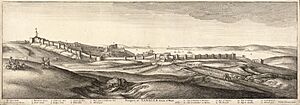
Tangier (1661–1684) was given to England by Portugal as part of the dowry for Catherine of Braganza when she married Charles II of England. However, this enclave was expensive to defend and fortify against attacks by Moulay Ismail. It also didn't offer much trade or military benefit to England. In February 1684, the English troops were sent home, the walls were torn down, and the harbor was destroyed.
European Settlements After 1830
In 1830, France invaded and conquered Algeria. In 1881, they made Tunisia a protectorate, meaning they controlled it. By these dates, there were no longer any European coastal enclaves in either territory.
In 1859, after an attack on Ceuta by local tribes, Spain started a war with Morocco. Under the 1860 treaty, Morocco officially recognized Spanish control over Ceuta and Melilla forever. Tetuan was temporarily given to Spain until Morocco paid its war costs (it was returned in 1862). Also, Morocco gave Spain the territory of an old, short-lived Spanish colony, which became the Spanish territory of Ifni.
At the Berlin Conference in 1884, Spain gained international recognition for controlling the area around the town of Sidi Ifni. During the Ifni War of 1957, Moroccan rebels took control of the territory around Sidi Ifni, but not the town itself. The entire territory was eventually given by Spain to Morocco in 1969.
From 1900, France and Spain agreed on areas of influence in Morocco. In 1912, they set up protectorates in their zones. However, the United Kingdom didn't want the important town of Tangier to be completely in French or Spanish hands. So, an international agreement in 1923 created the Tangier International Zone. This was a unique arrangement. The Sultan of Morocco still officially owned the territory, but it was managed jointly by Belgium, France, Britain, Italy, the Netherlands, Portugal, and Spain. The International Zone ended in 1956 when Morocco became independent.
Since 1956, the only European enclaves in North Africa have been Ceuta, Melilla, and the smaller islands called plazas de soberanía.
Spanish outposts acquired after 1830:
- Ifni (1860–1969)
- Tétouan (1860–1862)
- Islas Chafarinas (since 1848)
Images for kids
-
Fortifications of Agadir
-
Portuguese fort of Essaouira
-
Sea walls of Safi
-
City walls of Tangier
-
El Kala or La Calle, formerly Bastion de France
-
Red Castle of Tripoli
See also
- Portuguese Empire
- Presidio
- Plazas de soberanía


